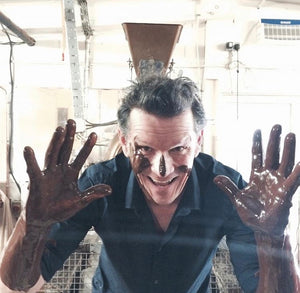Gourmet Boutique was lucky enough to host Willie Harcourt-Cooze for a tasting in our store in June. Since buying his cacao farm in 1996, Harcourt-Cooze’s passion for chocolate only continues to grow. His knowledge of food is astounding. Even as Willie presents samples, talking about sourcing the ingredients for each one, he’s full of life. His eyes light up and he’s extremely animated — using big, broad gestures as he talks about matcha or sea salt. His vocal cadence rising and falling with great vigor as he discusses the purity of his product. It’s nothing short of marvelous to watch him share his love of chocolate. He looked around the store before the tasting began. He mused over things that were new to him, as well as the brands that he knew well. He shared stories of friends that had founded other brands. He was quick to point out their passion. He kept going back to that being the root of a good chocolate maker — passion.

Willie grew up on an island off the coast of Ireland. It was there he found his love of food. His family made their own food including yogurt, cheese, bread, and even salt. They smoked fish and pickled fruit. Willie was not a fan of chocolate as a kid because it was too sweet. I asked if there was another treat he enjoyed growing up. His shook his head. “I mean we were into food. I was fishing. I was into different foods. We made our own wine. I made my own beer. You know, we were making everything really.”
He now has his own daily chocolate ritual. When asked if he has a favorite savory cacao dish, he becomes very animated. “Yeah, yeah, homemade bread (brown bread), half an avocado, two fried duck eggs, heavy grated 100% cacao, a little bit of chili oil. I have it every day. And hot chocolate. It’s all about the way it makes me feel. I like the chocolate hit.” He talks about the history of chocolate, Theobroma Cacao or “food of the gods.” He tells me about the traces of cacao that were found in ancient burial chambers and the techniques of the Aztecs. “You know, the Aztecs were roasting it, grinding it. So, you know, they were pretty sophisticated about their food. You might say ‘Well, why do you think that?’ Well, in Mexico when the Spanish arrived they found the local people with their maize soaking it in a lime solution of lime and water, heating it to 70 degrees, draining it away — using it for agriculture, and then making the paste for tortillas which is the same process they use today. It wasn’t until the 1920s in America that they discovered that process released two amino acids that were fundamental building blocks for their diet. If the Aztecs, whose staple diet was maize, and they were doing that to it — then what is it about cocoa that was revered as the food of the gods? I mean I drink hot chocolate every day. I’m really drinking hot chocolate for the way it makes me feel. It releases endorphins, it picks you up. It’s full of vitamins and minerals. It’s a slow-release, whereas coffee is a fast high and it releases cortisone in your body which releases stress. It (coffee) is highly addictive because it gives you that sharp high. So, I always say, coffee is the poor man’s hot chocolate. Lots of the attributes are the same such as a dark roast, light roast, medium, whatever. It doesn’t have the same value.” Willie is vivacious and talks quickly. The excitement he brings to the conversation is contagious. He’s a storyteller and I’m hanging on to every word. I’m also suddenly craving hot chocolate.
We spent a lot of the conversation talking about current trends of the chocolate world and what it takes to be a successful chocolate maker. According to Willie, there are three things required for good chocolate. “First thing, genetics. Second thing, the post-harvest — when the beans are fermented and dried which develops the flavors. The third thing is the chocolatier, which is probably the most important.” The process is a delicate one, a balancing of flavors. It can be ruined during the roasting and conching stages. Willie doesn’t use vanilla or soy lecithin. For him, the purity and simplicity of food are important.
A lot of brands, chocolate and otherwise, look for a particular viewpoint — something to separate them from the rest. Willie said, “Everyone is trying to find their platform, how they’re going to sell.” The craft chocolate movement, in particular, is full of brands selling unique chocolate. Bean-to-bar brands focus on minimal ingredients to highlight the flavor of the cacao. Most of these brands are American, so I wanted to know what he thought of the movement from a European standpoint. “Well, I think there’s been a big movement in the last few years where people have now started looking at ingredient lists to see what’s in there. I think foods changed, but we all did. America is certainly part of it and England is certainly part of it. England somehow became very over-processed. Whereas in France, Italy, Spain there is still very much artisans producing stuff.”
This brought us to how he sees his brand — chocolate that takes you on an adventure. After falling in love with the farm, Hacienda El Tesoro, he realized something. As Willie put it, “Hey, I got something to say. This is my in, so I’m running with it.” I was interested in what he meant by adventure. He said, “It’s taken me to visit those countries, the different flavors, and interactions — to all those farmers in different countries. That’s given me an inside and I find that inspiring.” Willie cultivates personal relationships with the farmers he works with. When talking one of those farms he said, “It’s very personal. We’re all on WhatsApp.” He chuckled. “He’s a friend, you know.”
I wanted to know his vision for the future of chocolate. What flavors are going to be big? He said he’s always looking for the next wave of trends. “Right now it’s salt. It opens up your taste buds. Who knows what the next one will be?” He’s a fan of using nuts and fruit in his 100% bars. “I mean, I’ve done a lot of nutty business. I love pistachio. I’ve found dates to be interesting. So I’ve done pistachio and date, a sort of middle eastern thing. I’ve gone cashew nut mad. It brings a lot of butteriness to the chocolate, so there’s a reason why. It’s not just mindlessly thrown in.” He’s always looking for new inspiration and ingredients. He does want to reach a mainstream audience, to share simple good chocolate. It’s personal for him. “For me, I’m romantically involved with all my bars. If I’m making a matcha bar or whatever bar, I source the different ingredients that make it. So when I eat it, the romance is fulfilled, it’s there. You’re only as good as the last bar.”
Lastly, I asked him if he had any advice for those looking to break into the chocolate business. He said, “Keep costs down, start whatever way you can. Don’t think you need that fancy machine, just use whatever you can to make it, and be passionate. If you’re really passionate, you’ll have the motivation.” At Gourmet Boutique, we are passionate about chocolate and the stories behind each brand. Our time with Willie only inspired that love further. What’s your food story?
- Written by Addy Rose


